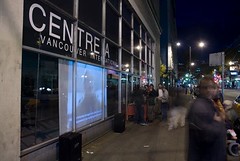I apologize that this blurb comes a couple of days late.
More LIVE5: To ATSA's DTES Screening Photo Set
Banks Suck: Presentation by ATSA
ATSA is a non profit org. created by two artists from Montreal, Annie Roy and Pierre Allard. I loved the images of their Sock Bank. This piece was inspired bytheincredible gap between the profit of major Canadian banks and the need for clean dry socks in the homeless shelters. In Montreal, the artists created Sock Banks out of discarded kitchen ovens covered with provocative slogans. People in need of dry clean socks were invited to discard or "retire" their old worn-out socks and pick up new ones.
In another project, the artists invited the army to create a working refugee camp in downtown Montréal. A temporary community inhabits the camp and with the help of social workers, doctors, artists, and volunteers including local chefs help to create a safe place where street people are cared for and treated with dignity and kindness. This has become a yearly event.
Concerned audience members asked questions about what the role of the artist is in these creating these temporary utopias-- instead of working on long-term solutions. Annie explained that she believes that the memory of these temporary experiences strengthen the community and makes change possible, especial in the way people in the neighborhood with food security and shelter treat the homeless.
One member of the audience cheekily suggested they do the refugee camp piece on a reserve in Canada, underscoring the point that native people have become refugees on their own land. The audience cheered.
The Risk Panel: Moderated by Vanessa Richards
The moderator and panelists on this panel pointed out that socially engaged artists risk being traumatized by their own projects, and that in fact in many ways practicing art is life-risking in itself. Newfoundland artist and educator Pam Hall talked about working as an artist dealing with issues in the Canadian medical system and fishing industries. She ended her talk by saying that sometimes it's necessary to go back into solitary practice to rediscover the joy that motivates her work as an artist, especially after years of dealing with deep emotional and social issues that cut so close to the bone.
Sara Kendall talked about the paralysis that can come about by thinking too much about real or imagined risks. Robin Brass showed us what risk looks and sounds like by playing video and audio documents of her powerful work. Hello curators, this woman needs to be brought to Vancouver to perform.
I was left with the impression that in this context risk taking is a transformative process requiring courage, passion, humility, and endurance. I was also thankful for these artists who embark on complex long-term projects in spite of the risks and stay focussed, compassionate, and committed through to the end of the process. These women provide us with such a brilliant contrast to the slick, ego-stroking solipsistic art practices that so many of us know all too well.
Jeremy Liu gave us a witty presentation on The Bitter Melon Council, which was a big hit with the audience. He aced the business presentation paradigm. We were very intrigued with the idea of "social homeopathy," in this case treating the bitterness in society with the healing properties of bitter melon. I will write more on the Bitter Melon Council later this week as they roam the streets of Chinatown promoting the benefits of this under-rated and relatively unknown super-food.
Ms. Dragu has written below about the Breakthrough Panel moderated by Glenn Alteen. I just wanted to add that like Margaret, I loved seeing the work of Valerie Salez. As a mother, I was charmed by her "art in the schools" snow shoveling project that ironically fulfilled the new mandate for the students to become more physically active in class. I wish we could have had time to see more of her work. Curators, please bring this woman back to Vancouver to do a project!
Lori Weidenhammer
Subscribe to:
Post Comments (Atom)


No comments:
Post a Comment